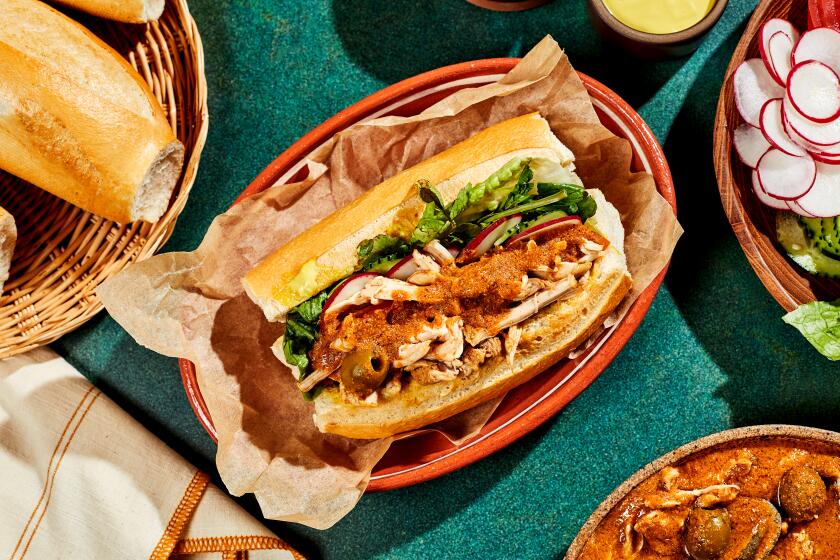Portobello and wild arugula sandwiches
- Share via
Whoever said you never forget your first time could have been talking about arugula. I remember I was in restaurant school in 1983 when a teacher passed out leaves while warning that women tended not to like it. One bite of that pungent pepperiness and I was lost.
Unfortunately, arugula has gone the way of so many exotic ingredients over the last few years: The aggressiveness seems to have been mainstreamed out. Forking through a salad’s worth, I start to sympathize with goats and other ruminants. Milder means duller.
But this summer I’m infatuated again. A cousin of arugula has started turning up in farmers markets, one with delicate, dainty leaves and even more pungent pepperiness.
Sold as wild arugula, it is actually cultivated -- it’s just another species of what everyone knows as arugula, according to the omniscient produce guru Elizabeth Schneider. In her encyclopedic “Vegetables From Amaranth to Zucchini” (Morrow), she says it is known as ‘Sylvetta.’
Myriad seed websites back her up on the nomenclature.
All I know is that this is the best thing to land in my farmers market since the zucchini blossom. A small bunch of wild arugula sells for twice what the one-degree-below-watercress kind does, but I would pay triple. The flavor and the texture are far superior. It’s much more like what you get in Italy, where they call it rocket.
I ate my first bunch like a peach as soon as I washed it, just as I used to when the original arugula taste was new. Then I tried it in salads and found that as good as it tastes solo, it might be even better as a sharp partner to milder greens such as butter lettuce. And the ideal destination is under a sizzling leg of duck confit: The fat wilts the bitter greens just enough to mellow the bite but not so much that they cannot do their job of balancing the fattiness of the meat.
Scatter at will
My new hot tip is to scatter wild arugula over sliced heirloom tomatoes and add just a drizzle of aged balsamic vinegar and the best olive oil in your arsenal. And my guilty secret is that wild arugula makes an exceptional addition to a nice greasy quesadilla: Again, the greens wilt just enough without surrendering like spinach, and the bite is almost a jalapeno-level counterpoint to the Cheddar or Monterey Jack.
Wild arugula would be great tossed into hot pasta with Parmigiano-Reggiano, folded into an omelet with Gruyere or goat cheese and sandwiched into a BLT. The pepperiness is the point.
I’ve also found that wild arugula will transform a semi-classic panzanella, the Italian bread-and-tomato salad that can almost be a main dish in summertime. Red onion, pancetta, cucumbers and salty olives play off and against the pungency of the vibrant greens. And in a warm portobello sandwich with pesto and melted cheese, wild arugula has just the right bite to counteract the richness.
Schneider also describes a tantalizing dish by Alain Ducasse: Regular and wild arugula are dressed with red wine, salt, pepper and olive oil and served alongside toasted bread with grilled goat cheese buttons sprinkled with thyme. The “normal” arugula extends the wild and is enlivened by those little leaves.
Oddly enough, although wild arugula is becoming more common in farmers markets in Los Angeles (Maggie’s Farm sells it at the Wednesday market in Santa Monica) and New York, it is still a rarity on restaurant menus in both cities. It has been spotted, though, coming out of a professional kitchen in San Francisco.
The farmer I buy from says it grows almost like a weed, at least when the weather cooperates. The bunches he sells on Wednesday are usually much daintier than those harvested by Saturday the same week. Which means home gardeners have an advantage. (The best leaves are less than 5 inches long and wildly spindly, unlike baby arugula’s, which are broad and eerily similar in size, as if they had come off a greenhouse assembly line.)
Wild arugula takes a little extra effort though, or it will wilt within hours of buying it. I’ve learned to wash and dry the trimmed leaves as soon as I get home, then layer them in paper towels in a plastic bag. They will last for days. Unless, of course, I eat even one. I know I won’t stop.
Combine the oil, garlic, tamari and black pepper to taste in a large shallow bowl. Add the portobello caps, turning to coat both sides. Let stand 30 to 60 minutes.
Roast the bell pepper under the broiler or over a flame until it is evenly charred on all sides. Cool, then remove the skin, seeds and tough ribs. Cut into thin strips and set aside.
Lay the portobello caps stem side up on broiler pan and drizzle with any remaining marinade. Broil 5 minutes, then turn over with tongs and broil 5 minutes longer. Turn once more, dredging the mushrooms through the pan juices, and broil 2 minutes longer.
While the portobellos are cooking, slice the ciabatta rolls in half and lay the halves out on the work surface. Spread the bottom half of each with pesto.
Place a hot portobello onto each pesto-covered ciabatta. Divide the cheese among the four sandwiches. Place an equal amount of pepper slices over each, then top with arugula. Press the top halves of the rolls onto the sandwiches. Slice in half diagonally and serve at once.
Get our Cooking newsletter.
Your roundup of inspiring recipes and kitchen tricks.
You may occasionally receive promotional content from the Los Angeles Times.















